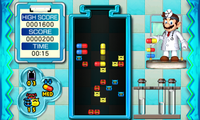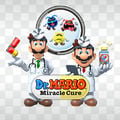Dr. Mario: Miracle Cure
Template:Infobox Dr. Mario: Miracle Cure is the seventh game in the Dr. Mario series, released for Nintendo 3DS in 2015. It was the final title in the Mario series to be released in the United States with Satoru Iwata as its executive producer, before his death on July 11, 2015.
Gameplay
The game features three modes to choose from: Dr. Mario, which is the series' standard gameplay; Dr. Luigi, which is the "Operation L" gameplay mode as seen in Dr. Luigi; and Virus Buster, in which players must drag continuously falling capsules onto the Viruses.
A new feature included only in Dr. Mario mode is the titular Miracle Cure. A Miracle Cure can be obtained by filling up a gauge that sits beside the bottle, and each Miracle Cure has a different effect, such as destroying all Viruses and Megavitamins of a single color, a bomb that destroys all surrounding Viruses and Megavitamins, and an item that clears out an entire row or column. These can also be turned off when choosing the settings for gameplay like in past games.
There is also a multiplayer mode, which features online and local multiplayer. When playing locally, there are two options: Local Play, which allows two players with a copy of the game to play, and Download Play, in which the other player must connect to the system via 3DS download play to play with the player who owns the game. In this, players can play the classic Dr. Mario multiplayer, or one of two modes for Virus Buster; a mode in which players must match three capsules to destroy all Viruses, and a mode in which both players must work together to destroy the Viruses. Dr. Mario mode in multiplayer also includes its own Miracle Cures, such as speeding up the drop rate of the opponent's capsules, reversing their controls, and preventing them from rotating a capsule.
The single player mode consists of two types: "Miracle Cure Laboratory", which is a collection of pre-designed stages, and "Custom Clinic", which the player can configure the course settings and play, similar to the original Dr. Mario games.
Miracle Cure Laboratory stages
Training
- 1: Intro to Dr. Mario
- 2: Intro to Dr. Luigi
- 3: Advanced L-Capsules
- 4: Blasting Capsules
- 5: Z-Blasting Capsules
- 6: Blasting Viruses
- 7: Zap Attacks
- 8: Explosive Treatments
- 9: Miracle Cure Combos
- 10: Shocking Sabotages
Basic
- 1: On Call with Dr. Mario
- 2: On Call with Dr. Luigi
- 3: Mushroom Medic
- 4: Fire Flower First Aid
- 5: Efficient Treatment
- 6: Chain Training
- 7: Step It Up
- 8: Rainbow Riot
- 9: Step It Up 2
- 10: Rainy-Day Remedy
- 11: Head-to-Head Challenge
- 12: Head-to-Head Challenge 2
- 13: One-Move Medication
- 14: Four-Move Medication
- 15: Rapid Remedy
- 16: Pot Luck
- 17: Rapid Remedy 2
- 18: Two-Move Medication
- 19: Be the Best!
- 20: Be the Best! 2
Advanced
- 1: Coin Collector
- 2: Bottled Bottle
- 3: Grin and Bear It
- 4: Mining for Miracles
- 5: Virus Valley
- 6: Harmonic Healing
- 7: Superstar Science
- 8: Vertical Zapper Zinger
- 9: Exploderama
- 10: Musical Mayhem
- 11: P Switch Pushover
- 12: Rainbow Road
- 13: Three-Move Medication
- 14: Zap to Zilch
- 15: A Heartfelt Battle
- 16: Vertical Zapper Dropper
- 17: Strawberry Crop
- 18: Leave No Leftovers
- 19: Miraculous Recovery
- 20: Arch Nemesis
Gallery
Staff
- Main article: List of Dr. Mario: Miracle Cure staff
Trivia
- In South Korea, this game was released as an exclusive bundle game of Mario & Luigi: Paper Jam. It was only downloadable from May 26 to August 31, 2016.[1]
References
- ^ Dr. Mario: Miracle Cure, Nintendo of Korea
Template:BoxTop Template:DrMarioSeries




